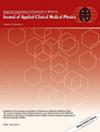Dosimetric evaluation of surface-guided tattoo-free approach for right sided whole-breast irradiation
Abstract
Background and purpose
In preparation for adjuvant breast radiation therapy (RT), permanent skin tattoo marks are often placed on the patient's skin to assist patient positioning on the treatment couch. However, those marks are often undesirable, in particular, for breast cancer patients due to various cosmetic and psychological concerns and other drawbacks. With surface-guided radiation therapy (SGRT) being readily available, it becomes possible to adopt a “tattoo-free” approach for patient setup. This study evaluates the efficacy and dosimetric implications of a tattoo-free setup technique.
Methods
Thirty right-sided breast cancer patients were included in this retrospective study. All patients received an initial course of whole breast treatment of 42.56 Gy in 16 fractions using a tangential 3D conformal technique, followed by a 10 Gy boost to the lumpectomy site in four fractions. SGRT was used in daily setup to reproduce patient's positioning between the simulation and treatment. The patient's breast surface was aligned with the corresponding reference breast surface generated from the planning computed tomography (CT) images via AlignRT system. To evaluate the feasibility and accuracy of the new tattoo-free approach, at the beginning of the program and for this group of patients, daily orthogonal kV imaging pair was performed to confirm the treatment positioning by verifying the bony landmarks, and the translational couch shifts were recorded for every fraction. Those shifts were applied to the isocenter positions of the original corresponding clinical treatment plans, and dose distributions were re-computed. The dosimetric evaluation between the two setup methods, that is, the breast surface alignment versus the bony landmark alignment, were then assessed on the original clinical plan. New plan sums were obtained from the 16 fractions, where each one was recalculated based on the new isocenter positions determined with the kV imaging shifts. Boost fractions were excluded in this study, as setup was verified using surgical clips as the matching reference.
Results
Translational shifts for the 30 patients (N = 480) were reviewed. The mean absolute shift resulted from the orthogonal kV imaging-based setup following the SGRT setup, in lateral, vertical and longitudinal directions, were 0.20 cm (ranged from 0 to 1.98 cm with 95% confidence interval (CI) of 0.18–0.22 cm), 0.23 cm (ranged from 0–1.25 cm with 95% CI of 0.21–0.25 cm), and 0.22 cm (ranged from 0 to 1.35 cm with 95% CI of 0.19–0.24 cm), respectively. The average change in V95% coverage over the treatment course of the 30 patients was 0.99%. No significant differences in V20Gy of lung (%) and mean heart dose were observed between the original and the corresponding shifted plans.
Conclusion
A SGRT based tattoo-free setup approach was clinically evaluated and compared to a kV orthogonal imaging-based approach for whole breast RT treatment. It was found that the tattoo-free setup approach is acceptable in treatment setup accuracy and dosimetric coverage. Caution needs to be paid to patient movement during setup and treatment to ensure the safety and efficacy of the approach.


 求助内容:
求助内容: 应助结果提醒方式:
应助结果提醒方式:


